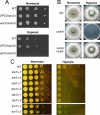Regulation of hypoxia adaptation: an overlooked virulence attribute of pathogenic fungi?
- PMID: 19462332
- PMCID: PMC2898717
- DOI: 10.3109/13693780902947342
Regulation of hypoxia adaptation: an overlooked virulence attribute of pathogenic fungi?
Abstract
Over the past two decades, the incidence of fungal infections has dramatically increased. This is primarily due to increases in the population of immunocompromised individuals attributed to the HIV/AIDS pandemic and immunosuppression therapies associated with organ transplantation, cancer, and other diseases where new immunomodulatory therapies are utilized. Significant advances have been made in understanding how fungi cause disease, but clearly much remains to be learned about the pathophysiology of these often lethal infections. Fungal pathogens face numerous environmental challenges as they colonize and infect mammalian hosts. Regardless of a pathogen's complexity, its ability to adapt to environmental changes is critical for its survival and ability to cause disease. For example, at sites of fungal infections, the significant influx of immune effector cells and the necrosis of tissue by the invading pathogen generate hypoxic microenvironments to which both the pathogen and host cells must adapt in order to survive. However, our current knowledge of how pathogenic fungi adapt to and survive in hypoxic conditions during fungal pathogenesis is limited. Recent studies have begun to observe that the ability to adapt to various levels of hypoxia is an important component of the virulence arsenal of pathogenic fungi. In this review, we focus on known oxygen sensing mechanisms that non-pathogenic and pathogenic fungi utilize to adapt to hypoxic microenvironments and their possible relation to fungal virulence.
Figures



Similar articles
-
Host Sensing by Pathogenic Fungi.Adv Appl Microbiol. 2018;102:159-221. doi: 10.1016/bs.aambs.2017.10.004. Epub 2017 Dec 7. Adv Appl Microbiol. 2018. PMID: 29680125
-
Hypoxia and fungal pathogenesis: to air or not to air?Eukaryot Cell. 2012 May;11(5):560-70. doi: 10.1128/EC.00031-12. Epub 2012 Mar 23. Eukaryot Cell. 2012. PMID: 22447924 Free PMC article. Review.
-
Fungal factors involved in host immune evasion, modulation and exploitation during infection.Cell Microbiol. 2021 Jan;23(1):e13272. doi: 10.1111/cmi.13272. Epub 2020 Oct 13. Cell Microbiol. 2021. PMID: 32978997 Review.
-
A sterol-regulatory element binding protein is required for cell polarity, hypoxia adaptation, azole drug resistance, and virulence in Aspergillus fumigatus.PLoS Pathog. 2008 Nov;4(11):e1000200. doi: 10.1371/journal.ppat.1000200. Epub 2008 Nov 7. PLoS Pathog. 2008. PMID: 18989462 Free PMC article.
-
Unravelling fungal pathogenesis: Advances in CRISPR-Cas9 for understanding virulence and adaptation.Fungal Genet Biol. 2025 Jun;179:104006. doi: 10.1016/j.fgb.2025.104006. Epub 2025 May 25. Fungal Genet Biol. 2025. PMID: 40425072 Review.
Cited by
-
Implications of hypoxic microenvironments during invasive aspergillosis.Med Mycol. 2011 Apr;49 Suppl 1(Suppl 1):S120-4. doi: 10.3109/13693786.2010.495139. Epub 2010 Jun 21. Med Mycol. 2011. PMID: 20560863 Free PMC article. Review.
-
Hypoxia: A Double-Edged Sword During Fungal Pathogenesis?Front Microbiol. 2020 Aug 12;11:1920. doi: 10.3389/fmicb.2020.01920. eCollection 2020. Front Microbiol. 2020. PMID: 32903454 Free PMC article. Review.
-
Flavin mononucleotide-based fluorescent proteins function in mammalian cells without oxygen requirement.PLoS One. 2012;7(9):e43921. doi: 10.1371/journal.pone.0043921. Epub 2012 Sep 11. PLoS One. 2012. PMID: 22984451 Free PMC article.
-
Anaerobic growth and drug susceptibility of versatile fungal pathogen Scedosporium apiospermum.iScience. 2023 Oct 24;26(11):108304. doi: 10.1016/j.isci.2023.108304. eCollection 2023 Nov 17. iScience. 2023. PMID: 37965151 Free PMC article.
-
Sterol Regulatory Element Binding Protein (Srb1) Is Required for Hypoxic Adaptation and Virulence in the Dimorphic Fungus Histoplasma capsulatum.PLoS One. 2016 Oct 6;11(10):e0163849. doi: 10.1371/journal.pone.0163849. eCollection 2016. PLoS One. 2016. PMID: 27711233 Free PMC article.
References
-
- McNeil MM, Nash SL, Hajjeh RA, et al. Trends in mortality due to invasive mycotic diseases in the United States, 1980-1997. Clin Infect Dis. 2001;33(5):641–7. - PubMed
-
- Erecinska M, Silver IA. Tissue oxygen tension and brain sensitivity to hypoxia. Respir Physiol. 2001;128(3):263–76. - PubMed
-
- Carlsson PO, Palm F, Andersson A, Liss P. Markedly decreased oxygen tension in transplanted rat pancreatic islets irrespective of the implantation site. Diabetes. 2001;50(3):489–95. - PubMed
-
- West JB. Respiratory Physiology - The Essentials. 3 edn Williams & Wilkins; Baltimore, MD, USA: 1985.
Publication types
MeSH terms
Substances
Grants and funding
LinkOut - more resources
Full Text Sources
Medical
Miscellaneous

